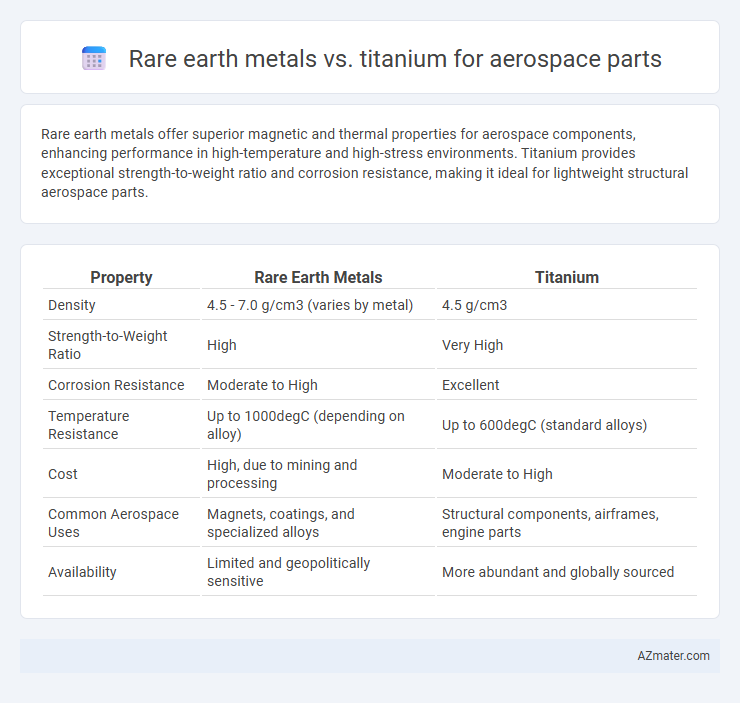Rare earth metals offer superior magnetic and thermal properties for aerospace components, enhancing performance in high-temperature and high-stress environments. Titanium provides exceptional strength-to-weight ratio and corrosion resistance, making it ideal for lightweight structural aerospace parts.
Table of Comparison
| Property | Rare Earth Metals | Titanium |
|---|---|---|
| Density | 4.5 - 7.0 g/cm3 (varies by metal) | 4.5 g/cm3 |
| Strength-to-Weight Ratio | High | Very High |
| Corrosion Resistance | Moderate to High | Excellent |
| Temperature Resistance | Up to 1000degC (depending on alloy) | Up to 600degC (standard alloys) |
| Cost | High, due to mining and processing | Moderate to High |
| Common Aerospace Uses | Magnets, coatings, and specialized alloys | Structural components, airframes, engine parts |
| Availability | Limited and geopolitically sensitive | More abundant and globally sourced |
Introduction to Aerospace Materials
Rare earth metals and titanium are critical materials in aerospace due to their unique properties. Rare earth metals provide superior magnetic, catalytic, and thermal characteristics essential for advanced avionics and propulsion systems. Titanium offers exceptional strength-to-weight ratio, corrosion resistance, and high-temperature performance, making it ideal for structural components and engine parts in aerospace applications.
Overview of Rare Earth Metals
Rare earth metals, including neodymium, samarium, and dysprosium, play a critical role in aerospace applications due to their exceptional magnetic, optical, and catalytic properties. These metals are essential in producing high-performance alloys, permanent magnets, and electronic components that enhance the efficiency and durability of aerospace parts. Unlike titanium, which is prized for its strength-to-weight ratio and corrosion resistance, rare earth metals contribute specialized functionalities that improve the thermal stability and electromagnetic performance of aerospace systems.
Overview of Titanium Alloys
Titanium alloys, prized in aerospace applications, offer exceptional strength-to-weight ratios and corrosion resistance, essential for high-performance aircraft parts exposed to extreme conditions. Unlike rare earth metals, titanium alloys provide superior fatigue resistance and biocompatibility, making them ideal for structural components and engine parts. Advanced grades such as Ti-6Al-4V balance durability and machinability, driving widespread adoption in aerospace manufacturing.
Mechanical Properties Comparison
Rare earth metals often exhibit exceptional magnetic and corrosion resistance properties but generally lack the tensile strength and fatigue resistance of titanium, making titanium superior for aerospace structural components. Titanium alloys provide an excellent strength-to-weight ratio, high fracture toughness, and outstanding fatigue life, which are critical for withstanding extreme stress and cyclic loading in aerospace applications. Mechanical properties such as yield strength (approximately 900 MPa for titanium alloys) and elastic modulus (about 110 GPa) significantly outperform most rare earth metal alloys, establishing titanium as the preferred material for aerospace parts requiring durability and reliability.
Weight and Density Analysis
Rare earth metals, such as neodymium and yttrium, offer high strength-to-weight ratios but generally possess higher densities ranging from 6.5 to 9.7 g/cm3 compared to titanium's density of approximately 4.5 g/cm3. Titanium's lower density and excellent corrosion resistance make it a preferred choice for aerospace parts requiring lightweight yet durable materials. Weight and density analysis reveals titanium's advantage in reducing overall aircraft weight, enhancing fuel efficiency without compromising structural integrity.
Corrosion Resistance in Aerospace Environments
Rare earth metals and titanium both exhibit high corrosion resistance essential for aerospace components exposed to harsh environments, with titanium renowned for its exceptional oxide layer that prevents oxidation and maintains structural integrity in saltwater and acidic conditions. Rare earth elements enhance corrosion resistance when alloyed with metals, improving protective oxide films and resistance to pitting in aerospace-grade materials. Titanium alloys generally offer superior performance in prolonged exposure to high humidity, salt spray, and thermal cycling typical in aerospace applications, making them ideal for critical structural parts.
Thermal Stability and Performance
Rare earth metals exhibit superior thermal stability and maintain mechanical strength at temperatures above 1000degC, making them ideal for high-performance aerospace parts subjected to extreme heat. Titanium, while boasting excellent corrosion resistance and strength-to-weight ratio, typically retains its structural integrity only up to around 600degC before losing effectiveness. For aerospace components requiring sustained performance under intense thermal conditions, rare earth metals offer enhanced durability and heat resistance compared to titanium alloys.
Cost and Availability Factors
Rare earth metals often face high costs and limited availability due to complex extraction processes and geopolitical supply constraints, impacting their feasibility for aerospace parts. Titanium offers a balance of cost-effectiveness and widespread availability, with well-established global production chains supporting aerospace industry demands. Titanium's strong corrosion resistance and high strength-to-weight ratio make it a preferred choice when budget and supply reliability are critical factors.
Environmental Impact and Sustainability
Rare earth metals often require extensive mining processes that generate significant environmental pollution and habitat destruction, raising concerns about their sustainability for aerospace parts. Titanium, by contrast, offers greater recyclability and lower toxicity, making it a more eco-friendly material with reduced carbon footprint throughout its lifecycle. The aerospace industry increasingly favors titanium for its balance of high strength-to-weight ratio and improved environmental sustainability.
Application Suitability: Rare Earth Metals vs Titanium
Rare earth metals, known for their exceptional magnetic and electrical properties, are ideal for aerospace applications requiring specialized components such as sensors, actuators, and high-performance magnets. Titanium offers superior strength-to-weight ratio, corrosion resistance, and fatigue performance, making it the preferred material for structural parts like airframes, engine components, and fasteners. While rare earth metals optimize electronic and magnetic functionality, titanium excels in mechanical integrity and weight-sensitive aerospace structures.

Infographic: Rare earth metal vs Titanium for Aerospace part
 azmater.com
azmater.com